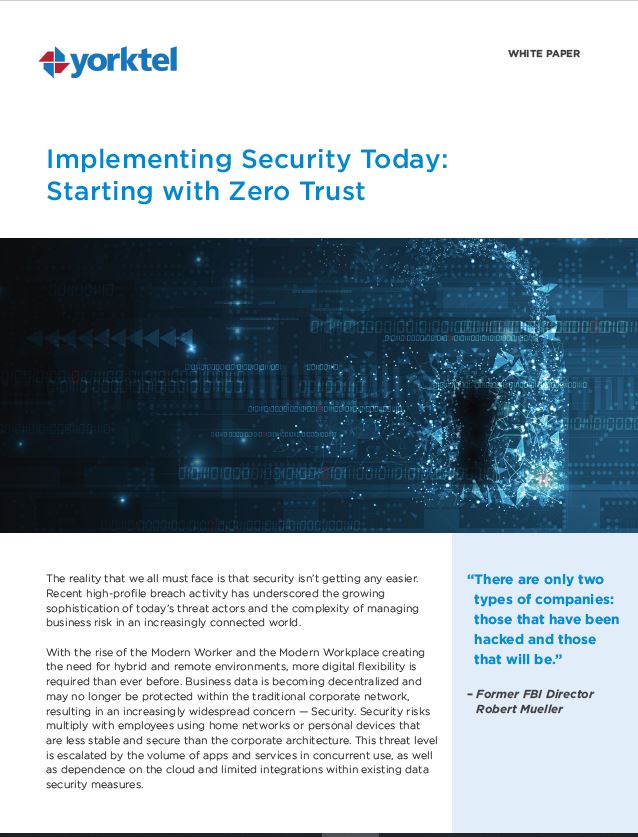Implementing Security Today: Starting with Zero Trust
Discover the steps you should take to implement a Zero Trust Security approach within your organization, helping protect you from cyber-attacks. It’s a very different approach to the traditional perimeter-based network perspective and is perfectly suited to an increasingly mobile workforce and the BYOD (Bring Your Own Device) model.
Achieving the Pillars of Zero Trust
In this whitepaper, we show you how a Zero Trust “assumed breach” approach is an effective security model with the principle of “trust no one, verify everything.”
We explain how to achieve each of these pillars:
- Identity Authentication – A control plane for Digitial Transformation
- Endpoint Management – Zero Touch IT, Device and Application Lifecycle Management
- Security Analytics – A Single Pane of Glass for All Security Data and Alerts
- Compliance – Management and Protection Within Compliance Standards and Regulations
Microsoft Teams Calling for the Modern Workplace & Worker
Over the last five years, a number of collaboration and communications tools have entered the workplace, including conferencing and messaging platforms, file share programs and Skype, followed by Teams and numerous other presence tools, that, added to the organization’s existing phone system and email server, resulted in an unhealthy smorgasbord. Users gained productivity tools with more features in exchange for fractured workflows, and organizations began to seek more uniformity.
Microsoft Teams has risen as a unifying platform that replaces many of the disparate options that organizations were struggling to integrate within a streamlined workflow. It reduced time and resources spent on weighed-down user workflows and eliminated the nightmare of disparate UC&C elements, with the exception of legacy phone systems.
In this whitepaper, you will learn how Microsoft Teams Calling removes inefficiencies and unifies voice in the context of an organization’s entire digital ecosystem; the different paths for migrating to Microsoft Teams Calling; and key factors in choosing a partner to implement this vital part of a digital workplace transformation strategy.
Post-Pandemic Planning For Microsoft Teams
Due to the rise of COVID-19, enterprises began shifting to Microsoft Teams much more quickly and more broadly than previously intended. For many of these organizations, Microsoft Teams best practices fell to the wayside in the interest of speed of adoption.
64% of organizations surveyed said that their Microsoft Teams rollout was not planned, and 76% admitted that they did not have a governance model in place.
As you begin planning for a return to the office, it’s important that you build a steady, workable foundation for the Microsoft Teams ecosystem in your enterprise.
In this white paper, we will provide recommendations for how to best manage Microsoft Teams in your current workplace setup, as well as how to prepare for the continued expansion of your Microsoft Teams deployment as your workers begin to return back to the office.
Evolution of Monitoring in the Age of Covid-19
The rise of COVID-19 has accelerated enterprise digital transformation to unprecedented levels. The focus has shifted from meeting rooms and centralized business hubs to entirely decentralized estates with exponentially more endpoints.
Now there is a much greater focus on the modern worker with multiple devices, more individual meeting rooms and an increase in the use of intelligent communications.
Learn how an innovative Monitoring solution could be a potential game-changer during this time of mixed environments, OEM devices, decentralization of the workforce and intelligent communications.
Solve Your Microsoft Teams and UC&C Challenges with a Gateway Service
You’ve deployed Microsoft Teams, or you’re thinking about it, but how can you bring Teams calls together with your existing collaboration estate?
Without a gateway between them, you risk creating technology silos and needing to rip and replace existing equipment. Seamlessly connecting existing standards-based H.323/SIP collaboration systems with Microsoft Teams Meetings is imperative in order to maximize the investment in both.
Learn what a gateway is and why it is so important, how to evaluate which gateway provider will be right for you and the vital part this will play in your Digital Transformation Strategy in our free whitepaper by Vishal Brown, Senior Vice President of Enterprise Product Management at Yorktel.
Moving from Skype to Teams? Don’t Miss these Seven Strategies for Success
This free White Paper gives you the seven steps you will need to transition successfully from Skype for Business to Microsoft Teams. Move with confidence, from understanding key features with …
Microsoft Teams: Is Your Network Ready?
One of the biggest mistakes companies make when transitioning from Skype for Business to Microsoft Teams is underestimating the network requirements for real-time communications. A wired and wireless Network Readiness …
Managing Change for Digital Workplace Transformations
Digital Workplace Transformations impact every aspect of an organization including facilities, processes, tech and workflow. This paper addresses change management during Digital Workplace Transformation and examines the following steps to ensure they succeed: 1. …
Best Practices for UC&C Productivity
UC&C can play an important role in improving how a business communicates and influences prospects, customers, business partners, stakeholders, and even its own workforce. Learn more in our Free White …
Finding Agility: The Next Generation Workplace
Making the commitment to embrace a Next Gen Workplace strategy by exploring new policies, procedures and cultural attitudes that reflect today’s workforce is a key requirement to developing a healthier …
3 Best Practices for Video Conferencing, Streaming Media, and Webcasts
Among all the communication mediums marketers have to choose from, there’s one fact that cannot be ignored: video content – including curated user-generated video and original branded content – is …











